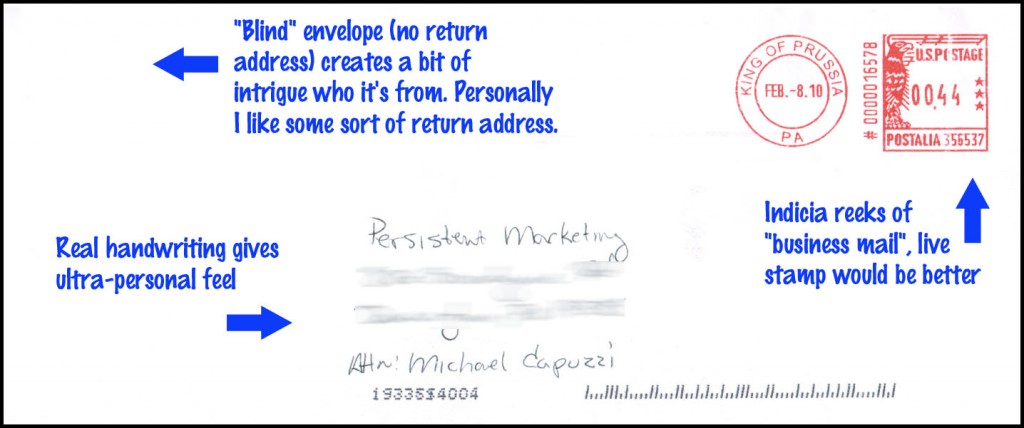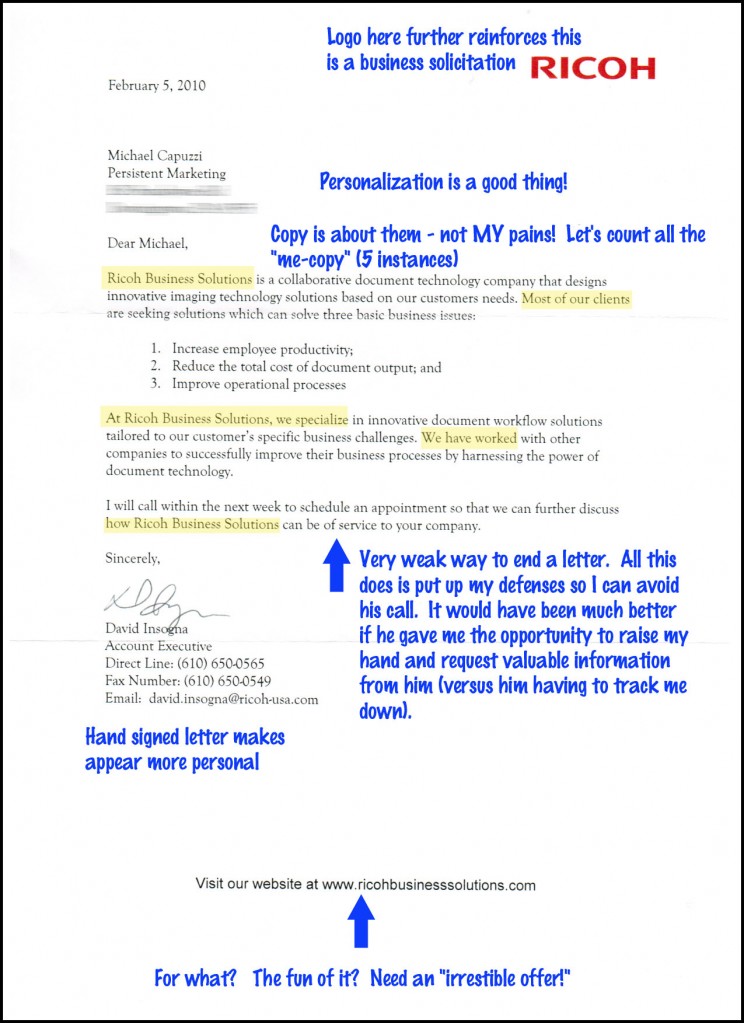Direct Mail Example: Does Your Marketing Cross the Goal Line?
I don’t know about you, but I enjoy getting my mail and looking through all the direct mail examples I receive, because each mailer is like a mini-marketing lesson… if you know what to look for.
Recently, I received a direct mail example that is an excellent teaching moment because I am going to show you how to create direct mail (and marketing campaigns in general) that cross the goal line, instead of being stopped just short. It’s a fact most business marketing will get somebody to a certain point in the marketing or sales process, and then not create the final and necessary steps to score (get the prospect to take action).
Since it’s football season, I thought a football metaphor made sense and in football jargon, it’s similar to getting to the five yard line and then not being able to get a touchdown. All the work to get them to a certain point has been done, but not the necessary final effort to make the touchdown.
This particular direct mail example exemplifies this short-coming. Let’s walk through both the letter and the envelope it came in. The blue notes are my notes to you to illustrate the good and bad points
When I first glanced at the envelope, it looked personal, except for the postage indicia which gave it away as something other than “me to you” mail. The envelope contained real handwriting, taking it to the five yard line, but then the company used a postage meter and did not include a return address, which prevented the score. I would prefer to have seen a real stamp used and some sort of return address information. While many marketers like using “blind” envelopes with no return information, in this day and age, this reeks of “junk mail” in my opinion. Even with these mistakes, the marketer receives a B+ for their envelope design effort.
Now let’s look at the letter contained in the envelope.
This letter is a classic example of doing a few good things, but several really dumb things that negate all the good work. First the good:
- Personalization typically increases response and increases conversion.
- Hand-signed signature conveys a real “me to you” letter so it appears to be coming from a real person.
Unfortunately, that’s about it for the good. Now for the bad:
- Logo at top of letter tells me right way this is not personal correspondence. A better strategy would have been to have something like “From the Desk of David Insogna” at the top.
- Copy is weak and is classic, corporate-style copy. It’s all about them and not the reader’s pains and concerns. When writing copy, always keep your prospect and his pains in mind. Remember, your reader is always thinking W.I.I.F.M – “what’s in it for me?”
- There is no strong call-to-action. No urgency. All the sender is doing is warning me that he’s going to call. It would have been much better if he gave me the opportunity to raise my hand and request information from him, to get me to engage.
- Telling me to visit their Web site without giving me a reason to visit is worthless and a waste of prime copy real estate.
- The other side of the letter was completely blank and could have been used for testimonials, etc. Never leave blank real-estate and take advantage of all white space.
So there you have it. A business-to-business direct mail example which had the makings of a pretty decent direct mail package, but due to a few fundamental mistakes, fails to cross the goal line.
Getting all the way to the five yard line, regardless of how you got there, doesn’t count for anything, unless you make the sale. If you’re going to do the hard work of marketing your product or service, make sure you go follow through and create marketing that grabs attention and converts.



Hey Mike, I am sooo grateful I found this post! I am getting ready to start a direct mail campaign to some local bizzes in my area who are spending money in our town’s monthly newsletter but do not list a website in their ad. So I want my campaign to be something creative so as to NOT sound like the example above!
I love that you showed in detail the good and bad.
Also, what do you think about including a “bulky” item related to the offer (to download my free report targeted directly at them)?
Thanks in advance for your feedback!
~Kesha
Kesha,
I’m glad my article could help! Bulky items/free reports are always a GREAT bonus to add to your online and offline marketing pieces to grab attention and increase your optins.
They’re also great to add to your business cards (just a little side tip)… check out this article –
https://mikecapuzzi.com/how-to-get-more-business-from-your-business-card-layouts/
I talk a little about using free offers on business cards, but might also give you some good hints and tips for your direct mail piece.
Here are also some tips for getting your direct mail piece opened that will help:
https://mikecapuzzi.com/direct-marketing-mail-how-to-create-envelopes-that-get-ripped-open-immediately/
Thanks for reading!
Mike
Hello Mike,
I first met you at a Michael Mclain seminar in Chicago a few years back. I currently do post card marketing to commercial niche markets. The last six months or so our response rates have dropped significantly.
I think my cards need a facelift. Could you help me?
Johnny O from Buffalo..
Hey Johnny, I remember you. The reason for the drop-off could be the result of many different things (the list, the message, the offer, the format, etc.). Check out my Consulting page here on the site and see if any of those options work for you. ~ Mike
This was really informative! It’s incredible how underutilized direct mail marketing is these days. Sure, social media and email marketing are mediums that should be taken advantage of, but you could surely make a case that direct mail is more effective than both of those aforementioned methods of marketing.